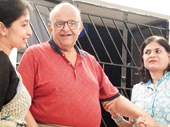 |
| Shyamanand Jalan with wife Chetna |
The small flat on the third floor of 6/7 AJC Bose Road is still and deserted. “Not here,” says Swapan Mitra, a Padatik official directed to keep Shyamanand Jalan’s ashes in a part of the building “where the most activity is”. The flat was after all only a place from where Jalan could access with ease “his lawyer’s chamber and the rehearsals downstairs.”
May 24 ended what had been for Jalan a double love affair — for the world of legal practices and of theatre and dance. Both of these he nurtured in the face of paralysis and cancer.
“His was a multifaceted personality,” says Chetna, Jalan’s widow and reputed kathak exponent and actor, sitting downstairs at the office.
“Not only because he was actor/director and lawyer, but because he really was too big for anyone to claim him as theirs. I have been with him from 18 to 62 and know that he was no one’s husband and no one’s father.... If he made you feel special he also made it clear that the others were there too.”
She is trying to follow her husband’s motto: “Keep doing, just keep doing.”
Born in 1934, Jalan debuted in Naya Samaj in 1949. This was followed by Tarun Roy’s Samasya in 1953. His long association with Tarun Roy’s Theatre Centre coloured his later dreams for Padatik. With Hindi theatre group Anamika, of which he was founding member, he was acting, translating and directing well-regarded productions (some of them opposite Chetna) such as Asadh Ka Ek Din, Chhapte Chhapte, Shuturmurg, Evam Indrajit, Pagla Ghora and Adhey Adhurey. In Tuglaq (1972), produced by Paschim Bangya Natya Unnayan Samity, he worked with Sambhu Mitra.
The same year he and Chetna launched Padatik, a charitable trust for dance and theatre. They produced Sakharam Binder, Hazar Chaurasi Ki Maa, Kauwa Chala Hans Ki Chaal, Kanyadaan, Raja Lear, Ramkatha Ramkahani and Madhavi, and brought in leading actors, writers and directors from all over India.
But Jalan’s greatest contribution was possibly the open air space under two mango trees that he later developed into the Padatik Buildwell Theatre. His wheelchair confinement required theatre to be brought home. He continued to direct plays and dress up the intimate space with the latest technical facilities.
While rehearsing his last directorial venture Lahron Ke Rajhans, Jalan had told Metro that the 100-seater alternative space could be the answer to group theatre’s problems: “At Padatik you can do theatre without tears. Against a deposit of Rs 300, groups get lighting equipment and some props, so even an audience of 20-30 for a show is enough.”
One hopes an incomplete venture by Jalan, the roof-top theatre, may also prove beneficial.
As Padatik member Jayasri Mitra says: “He had so much confidence in us that we still feel no matter how difficult it is, we can push through.”

